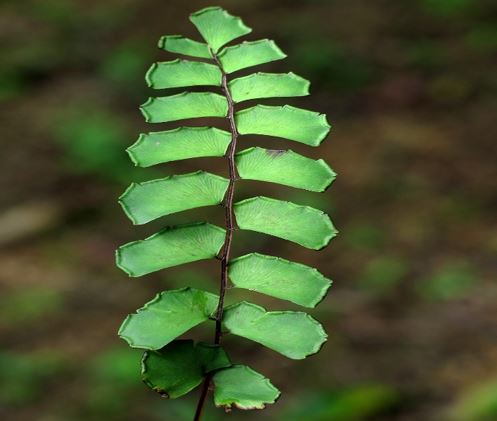A Comprehensive Review of Hansapadi (Adiantum lunulatum) - In Classical Texts
DOI:
https://doi.org/10.21760/jaims.10.4.15Keywords:
Adiantum, Hansapadi, Ethnomedical uses, Walking Maiden hair fern, TriparniAbstract
Ayurveda is a comprehensive and holistic system that offers a variety of drugs with various beneficial functions. Adiantum lunulatum, commonly referred to as "Maidenhair fern,” is a plant that is widely planted as an ornamental in India. This drug has important ethnobotanical and medicinal uses. This herb grows in an area near a water source and moist place and grows to a height of 1-1.5 feet. Root-brownish, branches- thin, leaves-small, soft with round dentate borders. The plant is described as a fern that grows in a creeping or sub-erect position. Fern is small, rhizomatous glabrous, and smooth. Hansapadi is having Kashaya Rasa, Guru Guna, Sheeta Veerya and Madhura Vipaka. It has been referenced in classical texts for its therapeutic actions such as Kasahara, Shwashara, Vranaropana, Shothahara, and Jwaraghna Karma. Different Nighantu defines synonyms such as Triparni, Keetamata, Padika, Godhapadi, Hansaraj, Raktapadi, etc. This article reviews the complete details of the drug, such as Morphology, Distribution, chemical constituents, Ethno-botanical claims, and Amayika prayoga (therapeutic uses).
Downloads
References
Mozambique Flora [Internet]. Available from: https://www.mozambiqueflora.com/speciesdata/species.php?species_id=101010.
Shaikh SD, Dongare M. Substrate analysis of Adiantum lunulatum Burm. from varied habitats of Sindhudurg District (Maharashtra). Eco Scan an Int Bi Annu J Environ Sci. 2008;2(2):173–6.
Lucina Portal [Internet]. Available from: http://lucina.inbio.ac.cr/portalDarwin/species/browse/taxon/77961, http://crbio.cr/portalCRBio/species/browse/taxon/323491.
Bhaugik M. Dhanvantari Nighantu. Sharma P (translator). 2nd ed. Varanasi: Chaukhambha Orientalia; 1998. p. 139.
Madanpal N. Madanpal Nighantu. Mumbai: Khemraj Shreekrishnadas Prakashana; 1998. p. 47.
Sharma AP, Sharma GP. Kaiyadeva Nighantu, Oushadhi Varga. Varanasi: Chaukhambha Orientalia; 2019. p. 141–2.
Sankhyadhar SC, Pandit SN. Raj Nighantu, Parpatadi Varga. Varanasi: Chaukhambha Orientalia; 2017. p. 180–1.
Chunekar KC. Bhavaprakasha Nighantu of Bhavamisra, English Commentary. Varanasi: Chowkhamba Vishvabharati Academy; 2017. p. 984.
Chunekar KC. Bhavaprakasha Nighantu of Bhavamisra, English Commentary. Varanasi: Chowkhamba Vishvabharati Academy; 2017. p. 298.
Chatterjee A, Pakrashi S. The Treatise on Indian Medicinal Plants. 1st ed. New Delhi: Publications and Information Director, CSIR; 1994. p. 7.
Anand RK, Srivastava RB. Ethnopharmacological study of Adiantum lunulatum Burn F. Indian Fern J. 1994;11:137–41.
Anis M, Sharma MP, Iqbal M. Herbal ethnomedicine of the Gwalior Forest Division in Madhya Pradesh, India. Pharm Biol [Internet]. 2000;38(4):241–53. Available from: http://www.tandfonline.com/doi/full/10.1076/1388-0209%28200009%293841-AFT241.
Reddy K, Reddy C, Trimurthulu G. Ethnobotanical survey on respiratory disorders in Eastern Ghats of Andhra Pradesh, India. Ethnobot Leafl. 2006;10(1):139–48.
(Repeated reference—same citation as above.)
Karthik V, Raju K, Ayyanar M, Gowrishankar K, Sekar T. Ethnomedicinal uses of pteridophytes in Kolli Hills, Eastern Ghats of Tamil Nadu, India. J Nat Prod Plant Resour. 2011;1(2):50–5.
(Repeated reference—same citation as above.)
Rout SD, Panda T, Mishra N. Ethnomedicinal studies on some pteridophytes of Similipal Biosphere Reserve, Orissa, India. Int J Med Med Sci. 2009;1(5):192–7.
(Repeated reference—same citation as above.)
Reddy VLN, Ravikanth V, Rao TP, Diwan PV, Venkateswarlu Y. A new triterpenoid from the fern Adiantum lunulatum and evaluation of antibacterial activity. Phytochemistry [Internet]. 2001;56(2):173–5. Available from: https://linkinghub.elsevier.com/retrieve/pii/S0031942200003344.
Kumari P, Govindapyari A, Mahmoudiotaghwari H, Bahuguna YM. Some ethno-medicinally important pteridophytes of India. Int J Med Aromat Plants. 2011;1(1):18–22.
Kaushik P, Dhiman A. Common medicinal pteridophytes. Indian Fern J. 1995;12:139–45.
Nadkarni A, Nadkarni K. Indian Materia Medica. 1st ed. Bombay: Popular Prakashan; 1976. p. 44.
Ambasta S. The Useful Plants of India. New Delhi: CSIR; 1986. p. 15.
Hosagoudar V, Henry A. Plants used in birth control and reproductive ailments by Soligans Biligiri Rangana Betta in Mysore districts of Karnataka. Ethnobot. 1993;5:117.
Vagbhata. Ashtanga Hridya. Tripathi RD (ed.). Delhi: Chaukhamba Sanskrit Pratishthan; 1992. Ch.5, p. 37.
Agnivesha, Charaka, Dridabala. Charaka Samhita. Trikamji Y (ed.). Varanasi: Chaukhamba Surbharati Prakashan; 2018. p. 283–4.
Sharma PV. Classical Uses of Medicinal Plants. Varanasi: Chowkhamba Vishvabharati Academy; p. 490.
Nishteswar K. Textbook of Dravyaguna. Varanasi: Chowkhamba Vishvabharati Academy.
Pandey G. Dravya Guna Vijnana (Materia Medica—Vegetable Drugs). 1st ed. Varanasi: Krishna Das Academy Oriental Publishers; 2001. p. 730–3.
Chauhan NS. Medicinal and Aromatic Plants of Himachal Pradesh. New Delhi: Indus Publishing; 1999. p. 452, 479, 510.
Indian Medicinal Plants, Vol. 2. Chennai: Orient Longman Pvt Ltd; 1994. Reprint 2006. p. 325.















